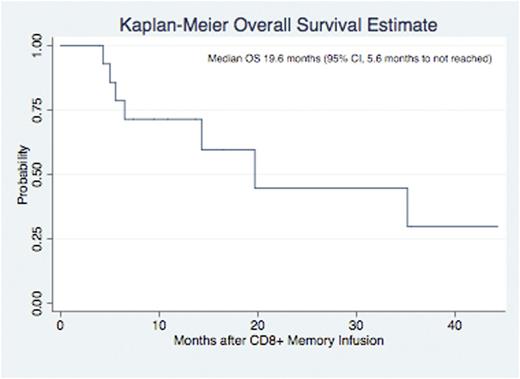Abstract
Background
Relapse remains the primary cause of failure following allogeneic hematopoietic cell transplantation (HCT). Unmanipulateddonor lymphocyte infusion (DLI) may induce immune-mediated graft-versus-tumor (GVT) reactions, but often elicits significant graft-versus-host disease (GVHD). Murine models of transplantation showed that a purified CD8+CD44hi memory T cell subset containing both central and effector memory cells was capable of eradicating malignant cells without inducing GVHD. We now report on a Phase I safety and feasibility study in which escalating doses of phenotypic CD8+CD45RA- memory T cells derived from HLA-matched sibling donors were administered to recipients with hematologic malignancies who relapsed after allogeneic HCT.
Methods
Eligible patients were 18-75 years of age with a hematologic malignancy that relapsed after allogeneic HCT from an HLA-matched sibling donor. Phenotypic CD8+ memory T cells were isolated following two days of unmobilized donor apheresis using a tandem immunomagnetic selection strategy including CD45RA depletion followed by CD8+ enrichment on the CliniMACS Plus instrument. Cell recovery and purity were determined by flow cytometry analysis. The study followed a standard 3+3 dose escalation scheme, with three patients enrolled at escalating dose levels of 1x106 cells/kg, 5x106 cells/kg, and 10x106 cells/kg; six additional patients were enrolled at the maximum tolerated dose (MTD).
Results
Fifteen patients received CD8+ memory T cell infusion at three dose levels. Median age was 59 years (range, 29 to 70 years). Diagnoses included acute myeloid leukemia (n= 8), non-Hodgkin lymphoma (n= 3), chronic lymphocytic leukemia (n= 1), chronic myeloid leukemia (n=1), multiple myeloma (n=1), and acute lymphoblastic leukemia (n=1). Median times from allogeneic HCT to disease relapse, and disease relapse to CD8+ memory T cell infusion were 508 days (range, 59 to 3214 days), and 236 days (range, 7 to 3005 days), respectively. Thirteen patients (87%) received cytoreductive therapy prior to CD8+ memory T cell infusion; six (40%) had returned to complete remission (CR) at the time of infusion. CD8+ memory T cell recovery, purity, and dose infused for each dose level cohort is detailed in Table 1. All patients in dose levels 1 and 2 received the intended CD8+ memory T cell dose of 1x106/kg and 5x106/kg, respectively. Five of the patients treated at dose level 3 received the planned 10x106/kg CD8+ memory T cell dose; however, the intended dose could not be obtained in four patients, who received doses of 7.8x106/kg, 8.0x106/kg, 5.2x106/kg, and 7.7x106/kg. There were no adverse events during CD8+ memory T cell infusion, and no dose-limiting toxicities occurred. GVHD developed in only one patient, was limited to grade II involvement of the liver, and resolved following a course of steroids. The median follow-up from the time of CD8+ memory T cell infusion was 328 days (range, 118 to 1328 days). Ten patients (67%) maintained or achieved response (7 CR, 1 partial response, 2 stable disease) for at least three months following CD8+ memory T cell infusion; four of the responders had active disease at time of infusion. Five patients (33%) had disease progression after CD8+ memory T cell infusion; all five had active disease at time of infusion. Among the ten responders, seven have relapsed at the time of this report after a median 165 days (range, 90 to 973 days) to relapse. Eight patients are currently alive; three are alive in CR and five are alive with active disease. For the entire study cohort, the median event-free survival and overall survival following CD8+ memory T cell infusion were 4.9 months (95% CI, 1 month to 19.3 months) and 19.6 months (95% CI, 5.6 months to not reached), respectively.
Conclusion
Phenotypic CD8+ memory T cell DLI is well tolerated and associated with a low incidence of GVHD. The MTD was not reached even at the highest dose of 10x106/kg; however, we were unable to consistently obtain this yield using the current cell selection strategy. Some patients achieved prolonged CR in this small heterogeneous study population. Future work will focus on methods to increase CD8+ memory T cell yield and strategies to enhance GVT associated with these cells.
1.DuttS, et al., Blood 2011 Mar 17;117(11):3230-9
2. Armstrong R, et al., BBMT 2011; 17(2, S1):p.S220.
Meyer:Stanford University: Patents & Royalties.
Author notes
Asterisk with author names denotes non-ASH members.




This feature is available to Subscribers Only
Sign In or Create an Account Close Modal